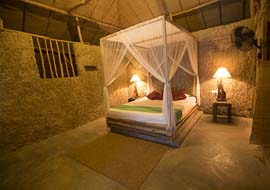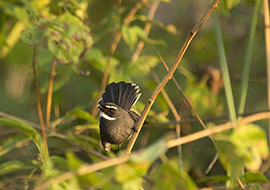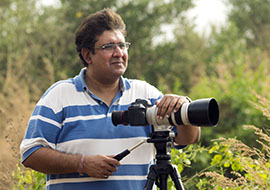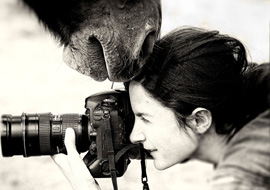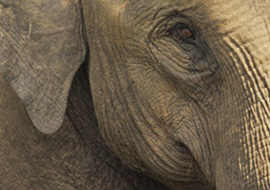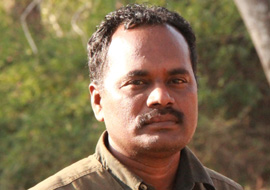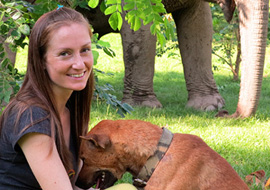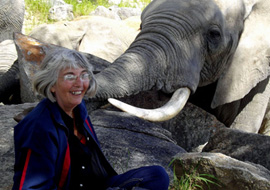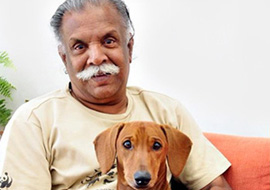- Shrilekha Venkateswar | The Wild Walk


How did the journey begin?
I grew up in Johannesburg, South Africa. As kids, my parents used to take us to look for wildlife. School holidays were spent at our National Parks in South Africa , like the famous Kruger National Park. With my two brothers and I, we would look for Elephant and Lions - I loved it. So from a young age I had an interest in wildlife. After school I went to Arts College and started working for an art department in a big factory that made clothes. My hobby was wildlife and bird watching, which I did on weekends. Eventually, bird watching became an obsession so I had to swap my hobby with my job, and bird watch all week. I applied for a job as a game ranger, and bird specialist at Phinda Reserve in Natal, South Africa, in 1991. Twenty years later, I am still a private wildlife guide taking people bird watching and animal viewing on safari, and I love every minute of it.
Mad Mike And Mark Show – How did the idea of making such a show come up and how did you get involved in it?
I was working in Kruger National Park filming Leopards and was offered a job in Botswana with Kevin Leo Smith on a new wildlife project. Kevin was open to the idea that we started working in film for marketing our wildlife project. So off I went to live in Botswana. About a year later, friend Simon Reeve moved from Australia to Botswana, we filmed and had many ideas. We had about ten top guides, all with different wildlife interests. I was filmed doing a wild dog segment. We had a fishing expert, anthropologist and Mike was to be the Lion expert. When we were filming Mike, he could only track and find an ostrich, so Mike was trying to work with the ostrich as if it were a lion, it was ugly. I knew Mike even before we did the show but we had never worked on camera together. When the Ostrich ran away, I got off the vehicle and was just messing about with Mike and his Ostrich encounter. The director said he want to do a piece with Mike and myself, and the rest is History.
Africa has many amazing wildlife areas, so there are lots of places to travel to and different types of animals to see. I am a safari guide, and a take people to see wildlife, and take photographs of the wild animals. I did this for more than ten years before we started working on the show. So I had a lot of experience working with wild animals before the show. You have to understand the animals before you can climb off a vehicle. Today I still take people on safari.
 Amazing Moments While Shooting Mad Mike And Mark
Amazing Moments While Shooting Mad Mike And Mark
The most amazing moment was the Cheetah that licked my head. That was in Kenya, where we spent five days filming that sequence . Slowly the cheetah got used to our presence, and eventually got inquisitive and came over and licked my head. It is the best moment of my wildlife career. We also have bad moments and one such was during the shoot of the first series of Mad Mike and Mark. We were under pressure to film and we were not getting our targets. We had not turned on a camera for days. We were waiting in a spot and the Elephants were a bit all over the place, the situation was not perfect. We got out of the vehicle and crept about 100 meters from the car. Wind changed direction and we were in the wrong position. Mike and I got caught between big herds of Elephant. We were completely surrounded, about 150 elephants. Some got angry and gave us many mock charges. We had to hide in the grass for an hour and a half. One female elephant mimicked how she was going to kill us. She got on her knees and stabbed the ground with her tusks. This was just a reminder of who's land we were trespassing in. Mike and I understand the risk when we get out of the vehicle.
 There are many children who go crazy hearing your name. They just adore you and consider you as an idol. How does it feel to be their role model?
There are many children who go crazy hearing your name. They just adore you and consider you as an idol. How does it feel to be their role model?
I would like to thank everybody in India who has watched our show, for without you watching I cannot share my conservation messages.
It is amazing to hear that our show is a great success, especially among young viewers. We are deeply thankful for that; but the real stars are the wildlife, I just share their stories. No matter who I take out on a safari, or how rich or how famous he/she is, they all take out their cameras, and take a photo - Of a lion, king of the jungle or silverback, from Gorillas in the mist. In twenty years I have never seen a lion or gorilla take out a camera and snap a picture of my clients; and on the safari, it is the rules of jungle’s, or the animals can get aggressive.
Tell us about 'Kissed by Cheetah' Experience
The cheetah sequence filmed in the Mara in Kenya, was the most amazing wildlife experience I have ever had, because a wild cheetah had the confidence to move up to us, and I sat there for hours with her only one meter away, and eventually she turned and got inquisitive and smelt me and kissed my head. She moved into our space, she controlled time. There is a risk in allowing an animal to touch you, I had over fifteen years of experience with Africa’s wild animals before I filmed this sequence.
 Working With Mike
Working With Mike
I have great respect for nature, and so does Mike. We were travelling in Namibia together last winter. Namibia is arid with a sparse summer rainfall. There is no water in winter. In the camp we were staying in, the ants discovered a small puddle of water in the bottom of the bathtub. There were hundreds of them and Mike found a feather and carefully removed each ant from the tub before he had a bath. This took thirty minutes, and this for me was great respect for wildlife. I did not film this incident, but it was amazing to watch as Mike tried to put each ant on the ant trail so it can find its way back to the nest.
Your show has also got a certain set of viewers who feel the show 'as getting too close to wild and disturbing animals and sending wrong signals to children'. What do you have to say about it?
Do not go close to African wildlife as many of the animals are very dangerous. Mike and I spent many years learning about the animals behavior before we made movies. We did not disturb any animals in the show. You do not see animals running away from us. In the first series, a few Elephants charge us and run away. This is typical Elephant behavior, especially as these aggressive Elephants were filmed at Kwando Safari’s in Botswana, where Elephants have been hunted for decades. I would also be angry if I was an Elephant.
What we see on television is a finely crafted show with these two amazing people taking jungle in their hands and educating the audience. Can you give us an insight on your shooting schedule and how it goes?
It might look like fun, but there is a lot of work that goes into a show. We are a group of six. We film while we travel, which makes it easy to get around. Everybody have their jobs to do, we are very well organized when we are on the road. Wildlife is tough to film because the animals do not do exactly what you want, and you cannot redo any shot. We try go to an area or country and have five ideas written down, and then find that animal and film that idea. We have five ideas per show. We then link it all together, mostly random ideas or something just happens which eventually links up all our five ideas. Every night we check the footage in case we need some extra shot for that sequence before we leave that area.
We start early, sometimes an hour before sunrise, as this is the best light and wildlife is active, so we have to get the equipment ready and drive to the right area, so the hours are long. We always film the whole day, in the evening we check footage, and prepare for the next day. All six of us are involved in the ideas and execution. Sometimes we have filmed for days and the footage does not work, and we have to just discard the footage. We have had instances where, Mike and I have sat up on a tree for three days and got not no footage. When we finish shooting, the footage goes to the edit team for editing; this takes weeks before we start seeing a rough copy, we watch this and make new changes. Then back to editing and then it goes to the TV network and you see it.
 What would be your description about African Forests to a person who has no clue about Africa?
What would be your description about African Forests to a person who has no clue about Africa?
Africa is not only a forest, but has many ecotype. Africa is so big that it is the space and size that is so amazing. Each forest has it’s own special trees and birds, and sometimes all of these happen in a small area. Hence the diversity is amazing. Africa has over 200 large mammals to photograph, where ever you go there is something different to look for.
In Africa National Parks are owned by governments, here you cannot get out of your car, you may not drive off road. You drive at your own risk, so if an elephant attacks you, you have to escape the best you can. (This is cheap for locals, and the cheapest way tourists can visit African wildlife; but it can be crowded, and the animals from birth become used to your cars). Usually animals graze in and out of the reserves and if they graze on a community land, I usually rent that community land and build a lodge ( I can now offer exclusivity, less people that pay more ). Then I hire great guides, the guides who are experts with wildlife, who can slowly teach those animals that there is no risk from vehicles and people. In time these animals behave as if the vehicle is not there. This is a skill, you have to be able to read animals and know when they are not happy with you . Then with a relaxed animal you will get better photographs, and that leads to more guests at better rates. Conservation wins, because a wildlife area can facilitate different financial sectors. Like a plane, first class is only for few and it costs more while in economy class you pay less and share the space with more people.
We in Africa have space, and it is easier to work with wildlife as they can walk away in the grass lands. When you work with wildlife in a jungle, it must have an escape route, so must you. This is much more challenging. It is also harder to track wildlife in a forest, so you find forest animals less than grassland animals. So your contact with the wildlife has to be much more skilled in a jungle.
 In terms of Eco tourism - India is not there yet. We still have a long way to go, while Africa, I believe has successfully implemented responsible tourism concept. What do you think India has to watch out for, while implementing Eco tourism?
In terms of Eco tourism - India is not there yet. We still have a long way to go, while Africa, I believe has successfully implemented responsible tourism concept. What do you think India has to watch out for, while implementing Eco tourism?
Everybody must get a percentage of the profits. More often the community leaders and chiefs are the only people that benefit and so the project fails.
How about community involvement in conservation in Africa? Has it increased in the last decade?
Most of our wildlife areas are owned by the community. they have to be partners for the project to thrive. Without them the project will fail.
Where does Africa stand in terms of conservation? Has it improved and what are the challenges that are faced by these game reserves.
Poaching is our biggest problem now. When world travellers stop travelling to Africa, poaching increases. No US Dollars coming in to the country would mean - no food. People eat the wildlife, and commercial poaching increases because we would eventually have less funds for wildlife teams to patrol the areas. Africa has serious Rhino problems.
We know that you're a avid birder. Share some of the wonderful locations you have been to and the experience there.
Bird watching is the perfect hobby, because where ever you travel on earth, there is some crazy bird that has adapted to that environment or food source . My favorite birding spots are Samburu National Park, because the aria environment allows you to see birds that are far away. There has also been no hunting in that area for decades, so you can get closer to birds here than most areas in Africa. Birds hate loud noises, they hate gun shots. So in areas that they hunt a lot it affects the birds. I can really relax with my clients when I bird here, it is easy to show people the birds. I also like birding in Queen Elizabeth National Park in Uganda. This reserve has more birds that any other reserve in Africa, just over 600. The forests are tough for bird watching because you only see the bird for a seconds, but the river boat cruise on the Kasinga Channel is exceptional. If I work hard I can see about 100 bird species in 2 hours. Phinda Reserve in Zululand South Africa is great because you get so many different habitats , with eastern and southern African vegetation types, this means more diversity, more birds to see, that works for me.
Have you even been to the Indian Jungles?
No I have never been; but i would love to visit sometimes.
 How do you make yourself available for younger generation? Do you conduct workshops and field trips to school students?
How do you make yourself available for younger generation? Do you conduct workshops and field trips to school students?
I do educational experiences with kids, because they are the future planet managers. I do one hour talks to schools in Johannesburg , I also do a day in the bush. I am also involved in sessions where kids can come into the bush for a week or ten days and I spend about two days on that program and do some talks with animal skeletons, walks and lessons on nature. I do this because it is important to me to share my knowledge.
So many people are so busy chasing money and dreams, but the environment should be part of your dreams, and this starts when nature is your class room and when we are young. Some school teachers should learn to be creative and have one lesson in a while outdoors, sitting under a tree. Use the environment and natures lessons.
What's your next project ? Any plans of writing a book? You have a lot of adventurous stories to tell the world and of course you are an excellent story teller.
I will do a book some day, but not now. For now, I am working on a talk, on the lessons that nature can teach business. What do animals do - not only survive but to thrive in challenging conditions, and how your company learn from this.
What is the biggest concern you have about future in terms of wildlife conservation?
Government greed and corruption, humans priority should be keeping the planet safe for future generations. Not seeing how much you can take. We should be trying to fit in around nature, not the other way around.

